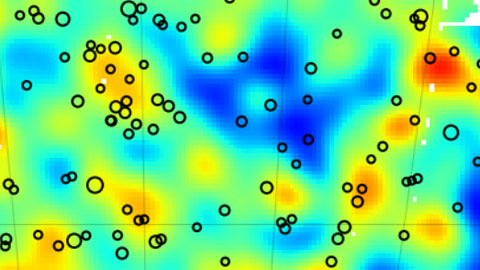Giant map of universe's dark matter published
Scientists of the Dark Energy Survey (DES) project have published the first of a series of maps of the universe's dark matter. The IFAE participates in the project and in the design and construction of the instrumentation used. The analysis helps to understand the role played by dark matter in the formation of the galaxies.

“We measured the barely perceptible distortions in the shapes of about 2 million galaxies to construct these new maps” says Vinu Vikram (Argonne National Laboratory, Chicago), lead researcher of the project. “We obtained very precise data thanks to the high sensitivity of the Dark Energy Camera.”
The Dark Energy Camera (DECam), a 570-megapixel imaging device capable of observing galaxies at a distance of nine million light years, is the primary instrument for the Dark Energy Survey. Located at the Cerro Tololo Inter-American Observatory in Chile, the DECam was specifically designed to measure the shape of the galaxy with unprecedented precision.
Spanish Contribution to the Project
The Institute for High Energy Physics (IFAE) at the UAB formed part of the DES project since the beginning. In the construction phase, the IFAE worked together with the ICE (IEEC-CSIC) and CIEMAT to design and build most of the electronics of the DECam. Moreover, two IFAE researchers worked on measuring the distance to the galaxies included in the survey.
Carles Sánchez, DES researcher at IFAE, explains that “Not only is it essential to measure the distance to the galaxies being observed, but also to understand in detail the precision of these measures, with the aim of using it in the study of dark energy”.
“With these new maps we will be able to study the evolution throughout time of the distribution of the universe's dark matter. This will give us important clues on the properties of dark energy”, adds Chris Bonnett, DES researcher at IFAE.
The Dark Energy Survey project is a collaboration of over 300 scientists from 25 institutions located in 6 different countries. IFAE, ICE (IEEC-CSIC) and CIEMAT represent the Spanish institutions collaborating in this project.
Filaments of Dark Matter
The dark matter maps are based on the first observations made by the DES and cover only 3% of the area which the project aims to analyse in the following five years. As the area analysed expands, researchers will be able to verify their cosmological theories by comparing the distribution of visible matter and that of dark matter.
Those theories suggest that, since there is much more dark matter in the universe than visible matter, galaxies will form where large concentrations of dark matter (and hence stronger gravity) are present. So far, the DES analysis backs this up: The maps show, on the one hand, large filaments of matter along which visible galaxies and galaxy clusters lie and, on the other, cosmic voids where very few galaxies reside.
Dark matter, the unknown substance which represents 75% of the universe's matter, is invisible even to the most sensitive astronomical instruments, since it neither emits nor absorbs light. However, its effects can be seen by studying a phenomenon called gravitational lensing. The light that reaches us from the most distant galaxies is bent because of the gravitational pull of the dark matter in between. This is the technique used in the DES, whose ultimate goal is to understand the nature of the mysterious dark energy which represents 70% of the universe's mass and energy and is believed to be causing the expansion of the universe to speed up.
The IFAE, a consortium between the Government of Catalonia and the Universitat Autònoma de Barcelona, is one of the centres belonging to the Catalan Government's CERCA programme, and in 2012 it received recognition as a Severo Ochoa Centre of Excellence.
More information
Link to maps:
http://deswl.github.io/page1/vikram_paper/Dark Matter Map IV.jpg
http://deswl.github.io/page1/vikram_paper/vikram_paper.html
Project's website:
http://www.darkenergysurvey.org/
Article: Wide-Field Lensing Mass Maps from DES Science Verification Data
http://arxiv.org/pdf/1504.03002.pdf
Image:
This is the first Dark Energy Survey map to trace the detailed distribution of dark matter across a large area of sky. The colour scale represents projected mass density: red and yellow represent regions with more dense matter. Clusters of galaxies are represented by gray dots on the map - bigger dots represent larger clusters. The dark matter maps reflect the current picture of mass distribution in the universe where large filaments of matter align with galaxies and clusters of galaxies. This map covers three percent of the area of sky which DES will eventually document over its five-year mission. (Dark Energy Survey)